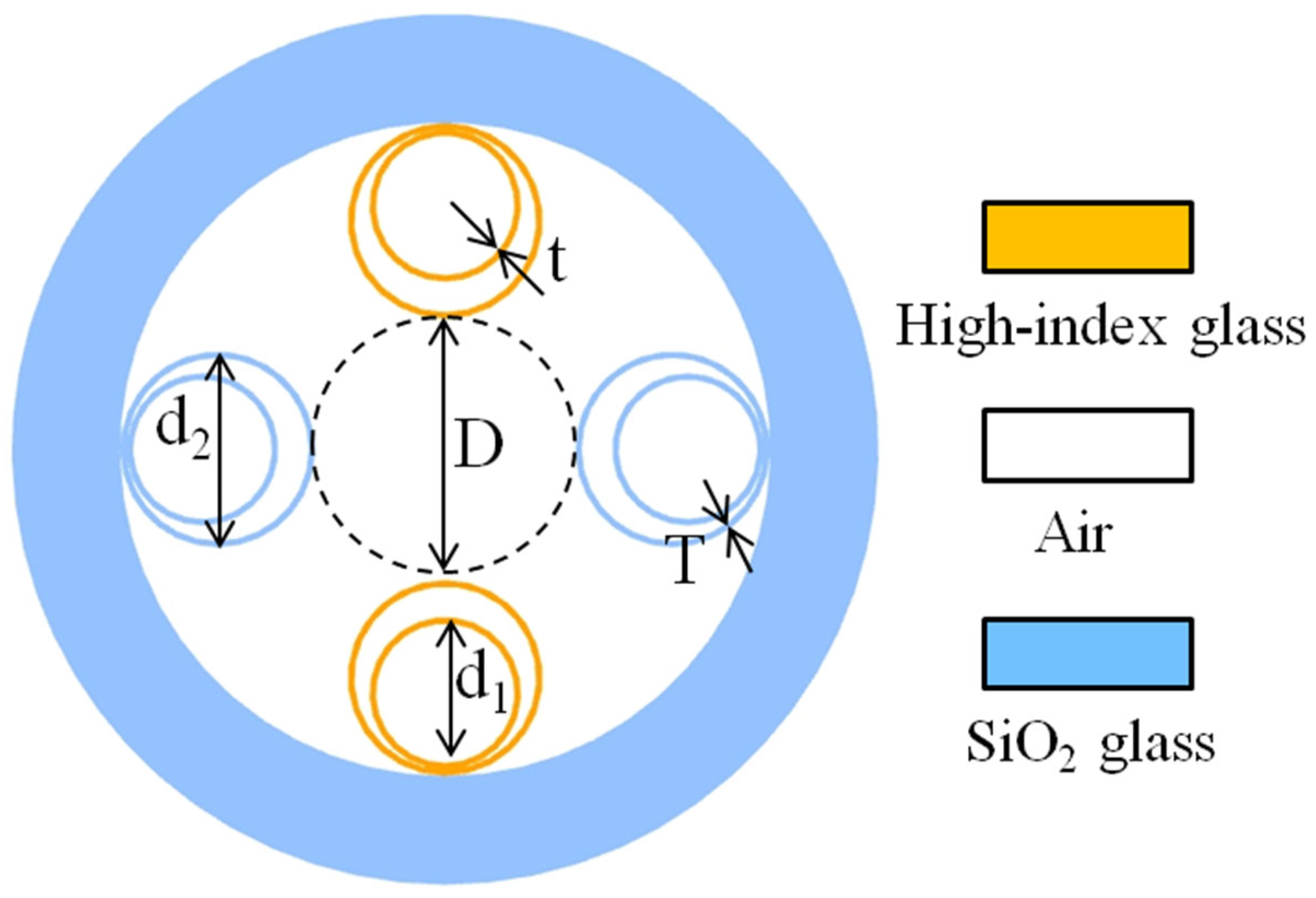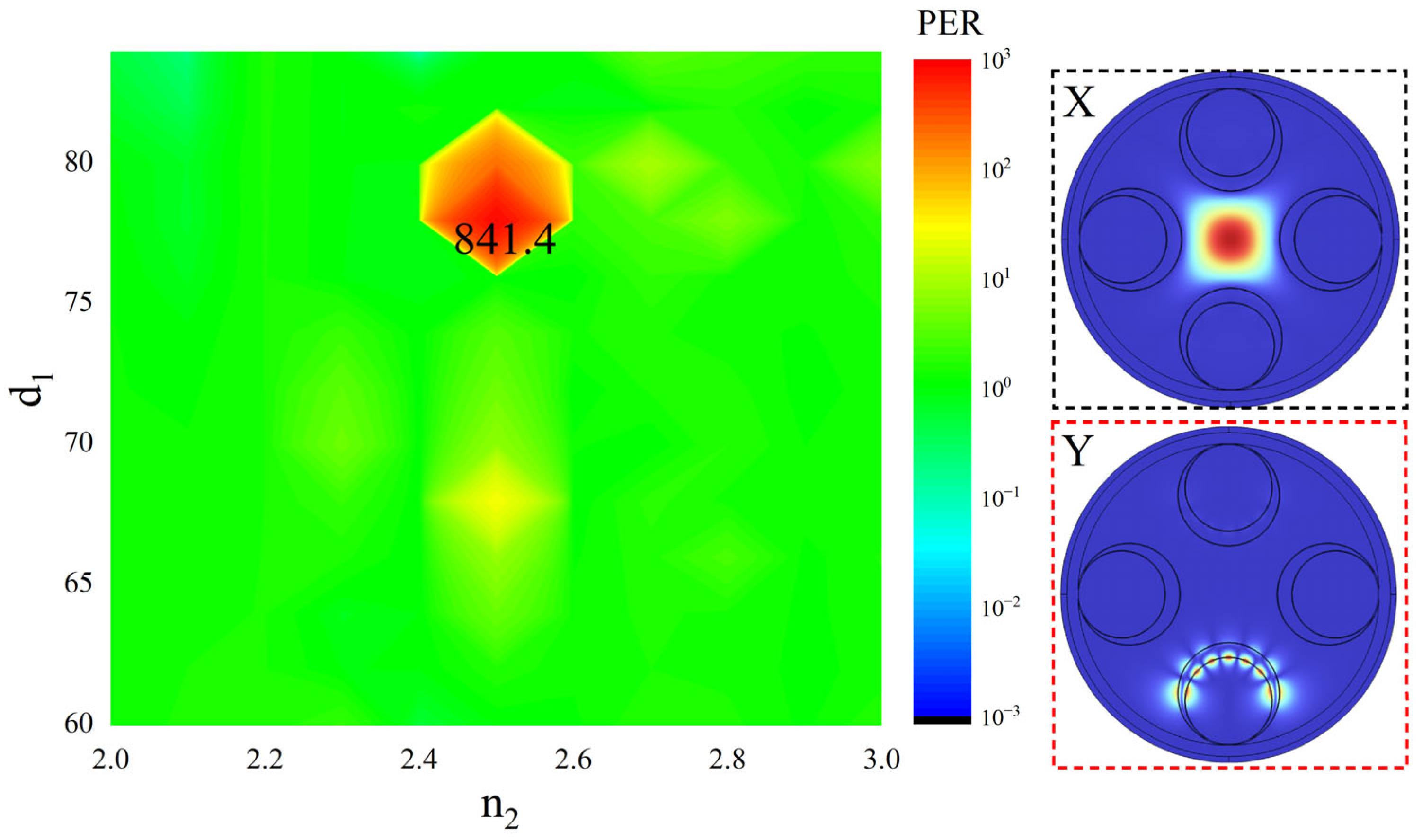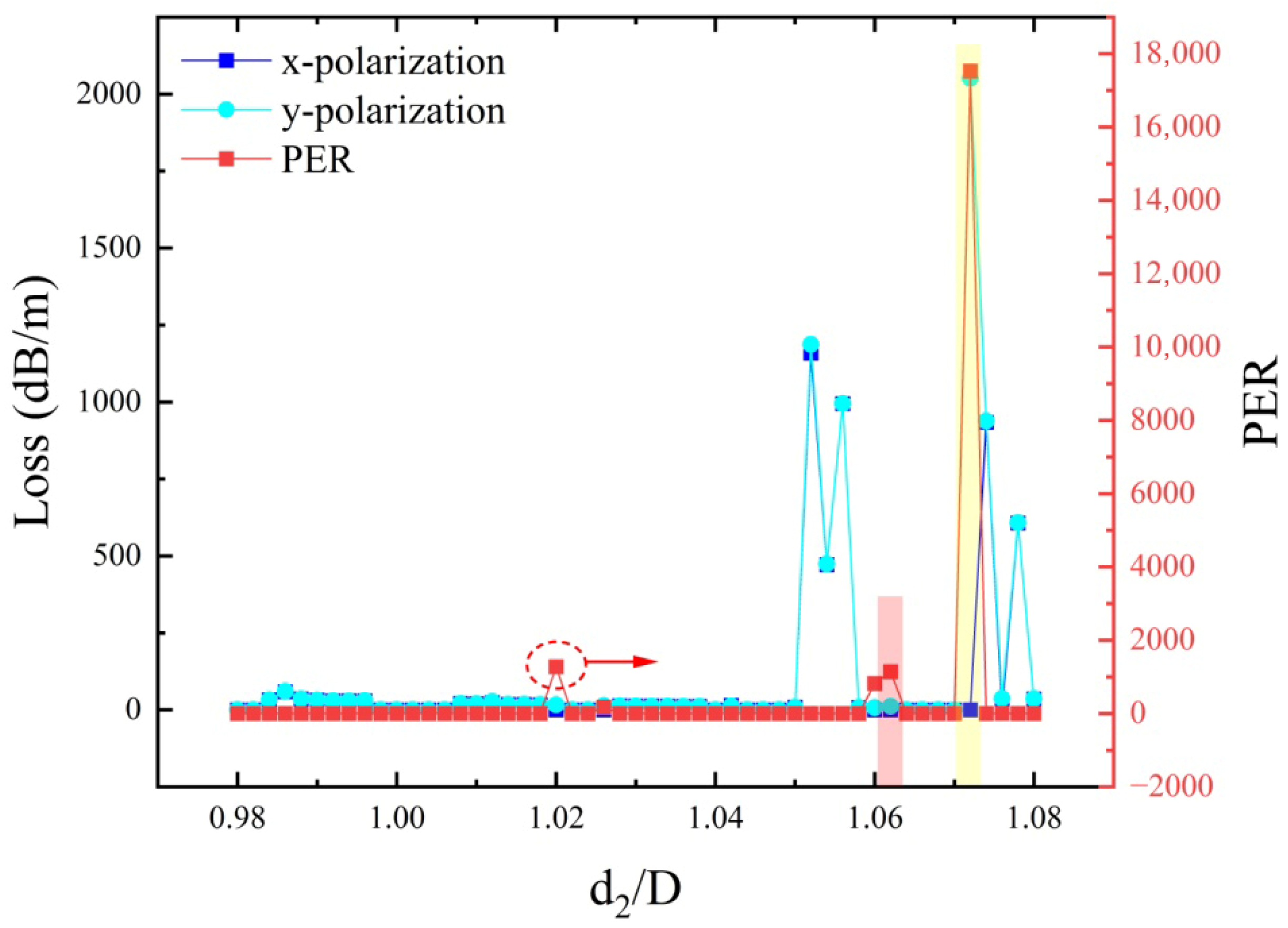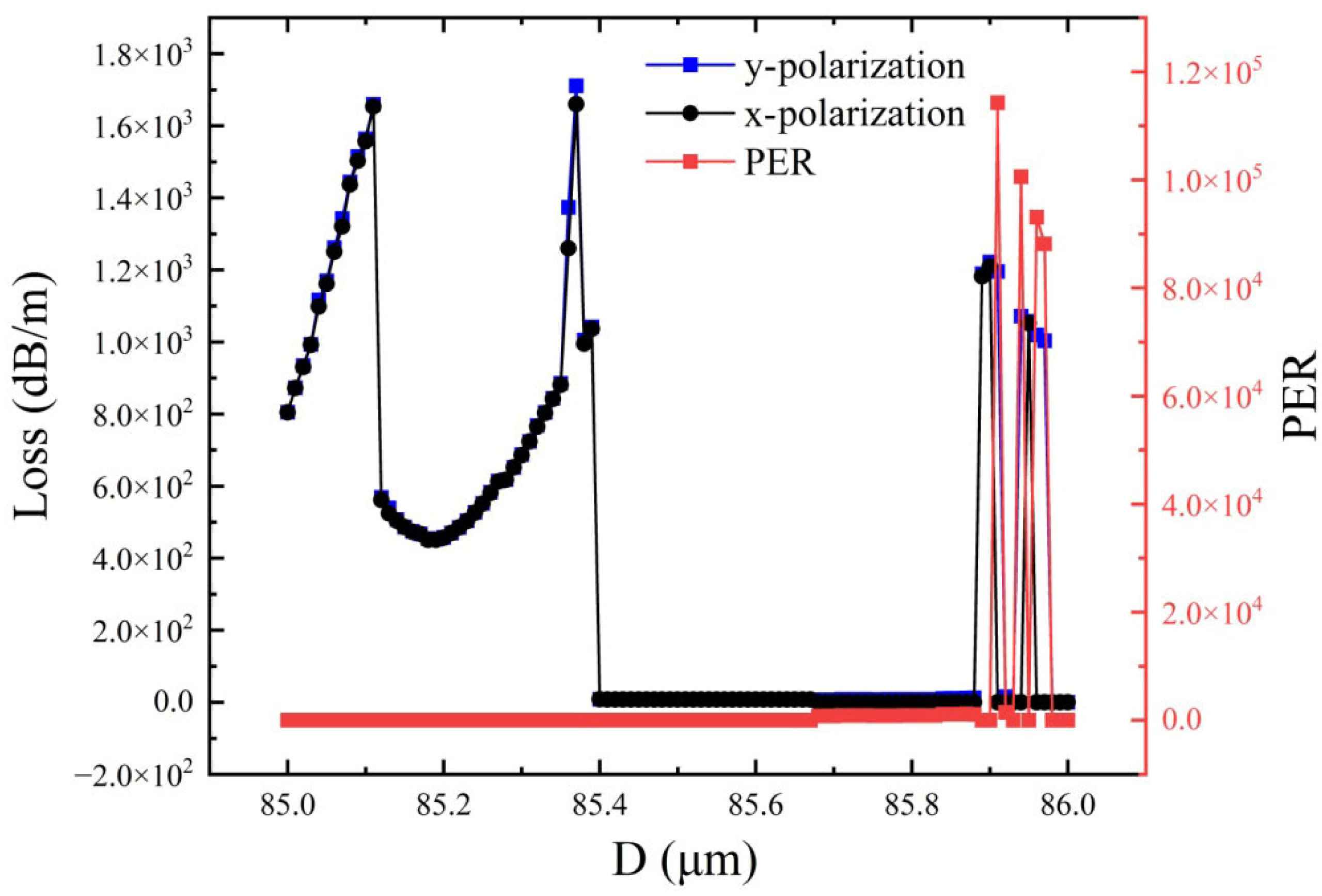Design and Characteristic Simulation of Polarization-Maintaining Anti-Resonant Hollow-Core Fiber for 2.79 μm Er, Cr: YSGG Laser Transmission
Abstract
1. Introduction
2. Design of Polarization-Maintaining AR-HCF for Transmission at 2.79 μm Wavelength
3. Results and Discussion
3.1. The Influence of the Inner Diameter of the Embedded Casing Pipe on PER
3.2. The Inner Diameter of the Jacketed Pipe Affects the PER
3.3. The Core Diameter Affects the PER
4. Discussion of Optical Fiber Manufacturing and Material Selection
5. Conclusions
Author Contributions
Funding
Data Availability Statement
Conflicts of Interest
Correction Statement
References
- Huang, L.; Wang, Y.; Zhang, Y.; Cheng, T.; Wang, L.; Jiang, H. High-efficiency 6-hole structure anti-resonant hollow-core fiber 2.79 μm Cr, Er: YSGG high-energy pulse laser transmission system. Opt. Laser Technol. 2024, 175, 110743. [Google Scholar] [CrossRef]
- Urich, A.; Maier, R.R.; Yu, F.; Knight, J.C.; Hand, D.P.; Shephard, J.D. Flexible delivery of Er: YAG radiation at 2.94 µm with negative curvature silica glass fibers: A new solution for minimally invasive surgical procedures. Biomed. Opt. Express 2013, 4, 193–205. [Google Scholar] [CrossRef] [PubMed]
- Huang, L.; Wang, P.; Wang, Y.; Cheng, T.; Wang, L.; Jiang, H. Mid-Infrared 2.79 μm Band Er, Cr: Y3Sc2Ga3O12 Laser Transmission Anti-Bending Low-Loss Anti-Resonant Hollow-Core Fiber. Photonics 2024, 11, 432. [Google Scholar] [CrossRef]
- Sincore, A.; Cook, J.; Tan, F.; El Halawany, A.; Riggins, A.; McDaniel, S.; Cook, G.; Martyshkin, D.V.; Fedorov, V.V.; Mirov, S.B.; et al. High power single-mode delivery of mid-infrared sources through chalcogenide fiber. Opt. Express 2018, 26, 7313–7323. [Google Scholar] [CrossRef]
- Wang, C.; Zhang, Z.; Tang, Y.; Jin, W.; Yang, T. Hollow optical fiber based spectroscopy gas sensing. Opt. Fiber Technol. 2024, 88, 103824. [Google Scholar] [CrossRef]
- Yu, F.; Knight, J.C. Negative curvature hollow core optical fiber. IEEE J. Sel. Top. Quantum Electro. 2016, 22, 4400610. [Google Scholar] [CrossRef]
- Wei, C.; Weiblen, R.J.; Menyuk, C.R.; Hu, J. Negative curvature fibers. Adv. Opt. Photonics 2017, 9, 504–561. [Google Scholar] [CrossRef]
- Gong, Y.; Meng, Y. Single-polarization single-mode broadband ultra-low loss hollow-core anti-resonant fiber with nested double C-type cladding tubes. Opt. Commun. 2024, 552, 130062. [Google Scholar] [CrossRef]
- Gao, S.-F.; Wang, Y.-Y.; Ding, W.; Wang, P. Hollow-core negative-curvature fiber for UV guidance. Opt. Lett. 2018, 43, 1347–1350. [Google Scholar] [CrossRef]
- Jaworski, P.; Krzempek, K.; Bojęś, P.; Wu, D.; Yu, F. Mid-IR antiresonant hollow-core fiber based chirped laser dispersion spectroscopy of ethane with parts per trillion sensitivity. Opt. Laser Technol. 2022, 156, 108539. [Google Scholar] [CrossRef]
- Popendaetal, M.A. Application of negative curvature hollow-core fiber in an optical fiber sensor setup for multiphoton spectroscopy. Sensors 2017, 17, 2278. [Google Scholar] [CrossRef]
- Litchinitser, N.; Abeeluck, A.; Headley, C. Anti resonant reflecting photonic crystal optical waveguides. Opt. Lett. 2002, 27, 1592–1594. [Google Scholar] [CrossRef] [PubMed]
- Wang, S.; Shan, C.; Jiang, J.; Liu, K.; Zhang, X.; Han, Q.; Lei, J.; Xiao, H.; Liu, T. Temperature-insensitive curvature sensor based on anti-resonant reflection guidance and Mach–Zehnder interferometer hybrid mechanism. Appl. Phys. Express 2019, 12, 106503. [Google Scholar] [CrossRef]
- Ni, W.; Yang, C.; Luo, Y.; Xia, R.; Lu, P.; Hu, D.J.J.; Danto, S.; Shum, P.P.; Wei, L. Recent Advancement of Anti-Resonant Hollow-Core Fibers for Sensing Applications. Photonics 2021, 8, 128. [Google Scholar] [CrossRef]
- Jaworski, P.; Yu, F.; Maier, R.R.; Wadsworth, W.J.; Knight, J.C.; Shephard, J.D.; Hand, D.P. Picosecond and nanosecond pulse delivery through a hollow-core Negative Curvature Fiber for micro-machining applications. Opt. Express 2013, 21, 22742–22753. [Google Scholar] [CrossRef]
- Nolan, D.A.; Berkey, G.E.; Li, M.J.; Chen, X.; Wood, W.A.; Zenteno, L.A. Single-polarization fiber with a high extinction ratio. Opt. Lett. 2004, 29, 1855–1857. [Google Scholar] [CrossRef]
- Din, W.; Wang, Y. Hybrid transmission bands and large birefringence in hollow-core anti-resonant fibers. Opt. Express 2015, 23, 21165. [Google Scholar]
- Wei, C.; Menyuk, C.R.; Hu, J. Polarization-filtering and polarization-maintaining low-loss negative curvature fibers. Opt. Express 2018, 26, 9528–9540. [Google Scholar] [CrossRef]
- Yuan, Z.; Wang, Y.; Yan, D.; Cao, M.; Meng, M.; Li, X.; Sun, S. Study on the high birefringence and low confinement loss terahertz fiber based on the combination of double negative curvature and nested claddings. J. Phys. D Appl. Phys. 2022, 55, 115106. [Google Scholar] [CrossRef]
- Yan, S.; Lou, S.; Zhang, W.; Lian, Z. Single-polarization single-mode double-ring hollow-core anti-resonant fiber. Opt. Express 2018, 26, 31160–31171. [Google Scholar] [CrossRef]
- Yang, S.; Sheng, X.; Zhao, G.; Li, S. Simple birefringent Terahertz fiber based on elliptical hollow core. Opt. Fiber Technol. 2019, 53, 102064. [Google Scholar] [CrossRef]
- Saitoh, K.; Koshiba, M. Single-polarization single-mode photonic crystalfibers. IEEE Photonics Technol. Lett. 2003, 15, 1384–1386. [Google Scholar] [CrossRef]
- Nazeri, K.; Bradley, C. The effect of photonic crystal fibre structure on the performance of Mach-Zehnder interferometer fibre optic gas sensors. Opt. Fiber Technol. 2020, 58, 102294. [Google Scholar] [CrossRef]
- Mousavi, S.A.; Sandoghchi, S.R.; Richardson, D.J.; Poletti, F. Broad band high birefringence and polarizing hollow-core anti-resonant fibers. Opt. Express 2016, 24, 22943. [Google Scholar] [CrossRef] [PubMed]
- Jasion, G.T.; Bradley, T.D.; Harrington, K.; Sakr, H.; Chen, Y.; Fokoua, E.N.; Davidson, I.A.; Taranta, A.; Hayes, J.R.; Richardson, D.J.; et al. Hollow Core NANF with 0.28 dB/km Attenuation in the C and L Bands. In Proceedings of the Optical Fiber Communication Conference Postdeadline Papers 2020, San Diego, CA, USA, 8–12 March 2020; Optica Publishing Group: Washington, DC, USA, 2020. [Google Scholar]
- Chang, Y.; Zhang, H.; Xu, Y.; Liu, C.; Xiao, X.; Guo, H. Low-loss nodeless hollow-core anti-resonant soft glass fiber for the 4 µm mid-infrared spectral range. Opt. Express 2024, 32, 23712–23721. [Google Scholar] [CrossRef]
- Zhu, J.; Feng, S.; Liu, C.; Cai, L.; Xu, Y.; Xiao, X.; Guo, H. Design and fabrication of a tellurite hollow-core anti-resonant fiber for mid-infrared applications. Opt. Express 2024, 32, 14067–14077. [Google Scholar] [CrossRef]





| Material | Refractive Index (λ = 2.79 μm) | Transparency | Note |
|---|---|---|---|
| As2S3 | 2.4–2.5 | Excellent | Mid-infrared main material, easy to prepare |
| As2Se3 | 2.8–2.9 | Excellent | Higher refractive index and lower loss |
| TiO2 | 2.6–2.7 | Absorbs a large amount | Absorption becomes significant when the wavelength exceeds 2.5 μm |
| Ge | 4.0 | Very well | High absorption, high refractive index; when used as the inner cladding, caution is required |
| ZnSe | 2.4 | Very well | Often used in infrared windows and laser optical components |
| ZnS | 2.3–2.4 | Very well | Can be used as a high-refractive index material |
| GaAs | 3.3–3.5 | Well | Used for infrared, but with a complex process |
| Ge10As20Se70 composite sulfur-based glass | 2.5–2.7 | Excellent | Refractive index and bandgap can be adjusted |
Disclaimer/Publisher’s Note: The statements, opinions and data contained in all publications are solely those of the individual author(s) and contributor(s) and not of MDPI and/or the editor(s). MDPI and/or the editor(s) disclaim responsibility for any injury to people or property resulting from any ideas, methods, instructions or products referred to in the content. |
© 2025 by the authors. Licensee MDPI, Basel, Switzerland. This article is an open access article distributed under the terms and conditions of the Creative Commons Attribution (CC BY) license (https://creativecommons.org/licenses/by/4.0/).
Share and Cite
Huang, L.; Wang, Y. Design and Characteristic Simulation of Polarization-Maintaining Anti-Resonant Hollow-Core Fiber for 2.79 μm Er, Cr: YSGG Laser Transmission. Optics 2025, 6, 37. https://doi.org/10.3390/opt6030037
Huang L, Wang Y. Design and Characteristic Simulation of Polarization-Maintaining Anti-Resonant Hollow-Core Fiber for 2.79 μm Er, Cr: YSGG Laser Transmission. Optics. 2025; 6(3):37. https://doi.org/10.3390/opt6030037
Chicago/Turabian StyleHuang, Lei, and Yinze Wang. 2025. "Design and Characteristic Simulation of Polarization-Maintaining Anti-Resonant Hollow-Core Fiber for 2.79 μm Er, Cr: YSGG Laser Transmission" Optics 6, no. 3: 37. https://doi.org/10.3390/opt6030037
APA StyleHuang, L., & Wang, Y. (2025). Design and Characteristic Simulation of Polarization-Maintaining Anti-Resonant Hollow-Core Fiber for 2.79 μm Er, Cr: YSGG Laser Transmission. Optics, 6(3), 37. https://doi.org/10.3390/opt6030037






